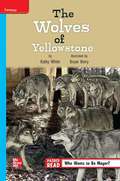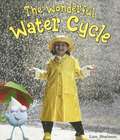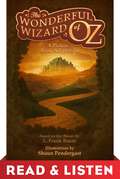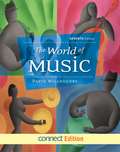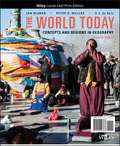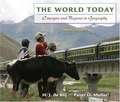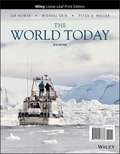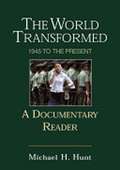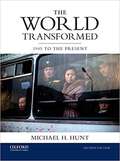- Table View
- List View
The Wonder of Hawaii (Into Reading, Benchmark 3-6, Level W #14)
by Heera Kang Jeff HopkinsNIMAC-sourced textbook
The Wonderful Water Cycle (Rigby Leveled Library, Level L #52)
by Lisa ShulmanNIMAC-sourced textbook
The Wonderful Wizard of Oz, A Picture Book Adaptation
by L. Frank BaumA striking picture book adaptation for ages 6 up of L. Frank Baum's classic children's novel The Wonderful Wizard of Oz, about the magical journey of Dorothy Gale, her dog, Toto, and her faithful friends to the Emerald City. No child's library is complete without this enchanting fantasy with its enduring themes of loyalty, resourcefulness, courage, and unforgettable characters, such as the Scarecrow, the Tin Man, the Cowardly Lion, and the Wicked Witch of the West. First published in the year 1900, the complete novel is one of the best-known original fairy tales in American popular culture.
The Wonderful Wizard of Oz, A Picture Book Adaptation: Read & Listen Edition
by L. Frank BaumA striking picture book adaptation with Read & Listen audio narration for ages 6 and up of L. Frank Baum&’s classic children&’s novel The Wonderful Wizard of Oz—the story about the magical journey of Dorothy Gale, her dog, Toto, and her faithful friends to the Emerald City. No child&’s library is complete without this enchanting fantasy with its enduring themes of loyalty, resourcefulness, courage, and unforgettable characters, such as the Scarecrow, the Tin Man, the Cowardly Lion, and the Wicked Witch of the West. First published in the year 1900, the complete novel is one of the best-known original fairy tales in American popular culture. Shaun Pendergast&’s bold, graphic illustrations offer a fresh take on the Land of Oz. An illustrator and designer of unique applications for mobile and tablet devices, Shaun grew up in the San Francisco Bay Area, and now lives in Austin, Texas. Visit him at shaunpendy.com.This ebook contains Read & Listen audio narration.
The Wood Ducks (Fountas & Pinnell Classroom, Guided Reading Grade 2)
by Beverley Randell Christina WaldNIMAC-sourced textbook
The World Around Me Studies Weekly: My Place in Time and Space
by Amy MinerNIMAC-sourced textbook <p>Grade 1
The World Around Us: Latin America and Canada
by James A. Banks Gloria Ladson-Billings Barry K. Beyer Gloria Contreras Jean Craven Mary A. Mcfarland Walter G. ParkerThis textbook contains many special features that will help you read, understand, and remember the people, geography, and history of Latin America and Canada.
The World Around Us: Regions Near and Far
by James A. Banks Walter C. Parker Barry K. Beyer Jean CravenGeography textbook
The World Around Us: The World Past and Present
by James A. Banks Walter C. Parker Gloria Ladson-Billings Barry K. Beyer Gloria Contreras Jean Craven Mary McfarlandThis textbook contains many special features that will help you read, understand, and remember the people, geography, and history of the world.
The World Atlas of Wine (7th Edition)
by Hugh Johnson Jancis Robinson"Immense and beautiful - almost drinkable" #65533;- Midweek, BBC Radio 4 "Simply superb work. . . buy it if you like wine at all. " #65533;- Victoria Moore, The Telegraph "If I owned only one wine book, it would be this one. And this edition, please. " #65533;- Andrew Jefford, Decanter Few wine books can be called classic but the first edition of The World Atlas of Wine made publishing history when it appeared in 1971. It is recognized by critics as the most essential and authoritative wine reference work available. This seventh edition will bring readers, both old and new, bang up to date with the world of wine. Much has changed since the last edition of the Atlas in 2007. Changes in climate, in winemaking technique, in fashion, and in where wine is grown over the past years are all reflected in this new edition. The move away from more predictable international grapes and towards less familiar, local varieties is a noticeable trend. Wine that expresses its precise location is once more to the fore, meaning that an Atlas that allows the reader to understand a region's geography is more necessary than ever. The increasing importance of cooler-climate regions as the effects of climate change become more apparent and the growth of China, not just as a consumer of wine but also as a grape-grower and wine producer, are just two of the many other developments covered. The Atlas is renowned for its superb cartography and this seventh edition has 215 unique maps. Dynamic wine regions such as coastal Croatia, Khaketi in Georgia, Canterbury in New Zealand, Swartland in South Africa, Northern Virginia in the US , and Ningxia in China are examples of just some that are covered in detail for the first time. Hugh Johnson and Jancis Robinson, the world's most respected wine-writing duo, have again joined forces to create a classic that no wine lover can afford to be without. Contents Includes. . . Introduction The Ancient World and Middle Ages The Evolution of Modern Wine International Grapes Regional Grapes Wine and Weather Making Wine in the Vineyard Making Wine in the Cellar Oak and its uses Stoppering Wine Anatomy of a Winery Wine and Time Enjoying Wine Tasting and Talking about Wine The World of Wine France Italy Spain Portugal Germany Austria Hungary Greece North America South America Australia New Zealand South Africa Asia And Much More!
The World Of Music
by David WilloughbyThe World of Music is a music listening book designed for the growing number of teachers who want to focus on listening to music as it exists in the real world of their students. Expanding the traditional repertoire used for music study, this popular text begins with American folk, religious, jazz, popular, and ethnic music before introducing some world music and concluding with a thorough overview of Western classical music. The approach captures the essence of each repertoire, and equips students to recognize different styles, appreciate their different functions, and possess a solid foundation for a lifetime of musical appreciation. The text also introduces students to the many styles of music currently enjoyed by people in the United States and helps them to appreciate the diverse roots of these styles. In addition, the text encourages its readers to appreciate different cultures around the world through an encounter with their music.
The World Past and Present East and West
by James A. Banks Gloria Ladson-Billings Barry K. Beyer Gloria Contreras Jean Craven Mary A. McfarlandMeant for middle school students,this is a detailed and informative book on the rich history of our world covering both eastern and western nations.
The World Today: Concepts And Regions In Geography
by Peter O. Muller Harm J. de Blij Jan NijmanThe World Today, Binder Ready Version, 7th Edition is the number one bestselling brief World Regional Geography textbook. The seventh edition continues to bring readers geographic perspectives on a fast-changing world through the regional view. Restructured chapters provide a macro review of important physical, cultural, and political characteristics, drawing upon up-to-date significant world events and crises. The cartographically superior maps have been updated for the seventh edition to offer an accurate and vast picture of the world--multi-layer, interactive, GIA maps have been added to WileyPLUS Learning Space. To complement the extensive map program, the majority of the photos have been taken by our authors during their field research, allowing the student to experience an authentic geographical viewpoint of our world.
The World Today: Concepts and Regions in Geography
by Peter O. Muller Eugene Joseph Palka H. J. de BlijTextbook on the geography of the world toward the close of the first decade of the twenty-first century as well as a guide to geographic ideas and perspectives, past and present.
The World Today: Concepts and Regions in Geography
by Peter O. Muller Michael Shin Jan NijmanIn the 8th edition of this market-leading title, The World Today continues to break new ground in the interpretation and teaching of world regional geography. The text explains the contemporary world’s geographic realms in terms of their natural environments and human dimensions in a clear and concise fashion. The authors look at the ways people have organized their living space, adapted to changing social as well as environmental circumstances, and continue to confront forces largely beyond their control ranging from globalization to climate change. <p> This book offers an approach to Geography that meshes theoretical concepts with regional realities. The evolving regional content of the chapters in the 8th edition of The World Today reflects the dynamic nature of the world’s geography; the changing and growing number of concepts mirror the progress of the discipline; and the ongoing introduction of new digital features reflects the instructional possibilities of new technologies.
The World Transformed, 1945 To The Present: A Documentary Reader
by Michael H. HuntDesigned to accompany The World Transformed, 1945 to the Present, this comprehensive reader offers a wealth of primary sources on the pivotal events that shaped the post-1945 world. Complemented by an editorial apparatus that supports and enhances students’ reading of the documents and helps them to understand the interlocking nature of historical developments, this invaluable collection will appeal to anyone teaching courses on post-1945 world history, international relations, the cold war and globalization.
The World Transformed: 1945 To The Present
by Michael H. HuntThrough its lively and accessible narrative, The World Transformed: 1945 to Present provides students with an account of the political, socio-economic, and cultural developments that have shaped global events since 1945. The book's focus on three central and profoundly interconnected stories--the unfolding of the Cold War, the growth of the international economy, and the developing world's quest for political and economic independence--offers students a framework for understanding the past and making sense of the present. Attentive to overarching themes, individual historical figures, and diverse nations--and now substantially revised with a new Part 4 that examines world events since 1990--The World Transformed, Second Edition, is ideal for courses on post-1945 world history, international relations, or global topics.
